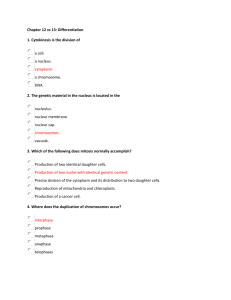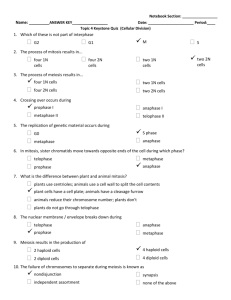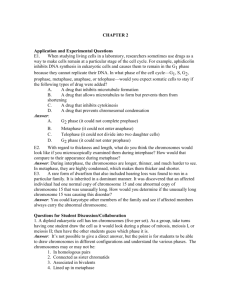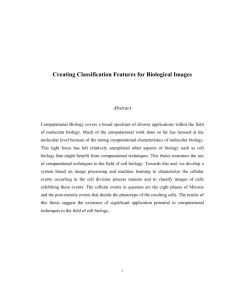Name
advertisement
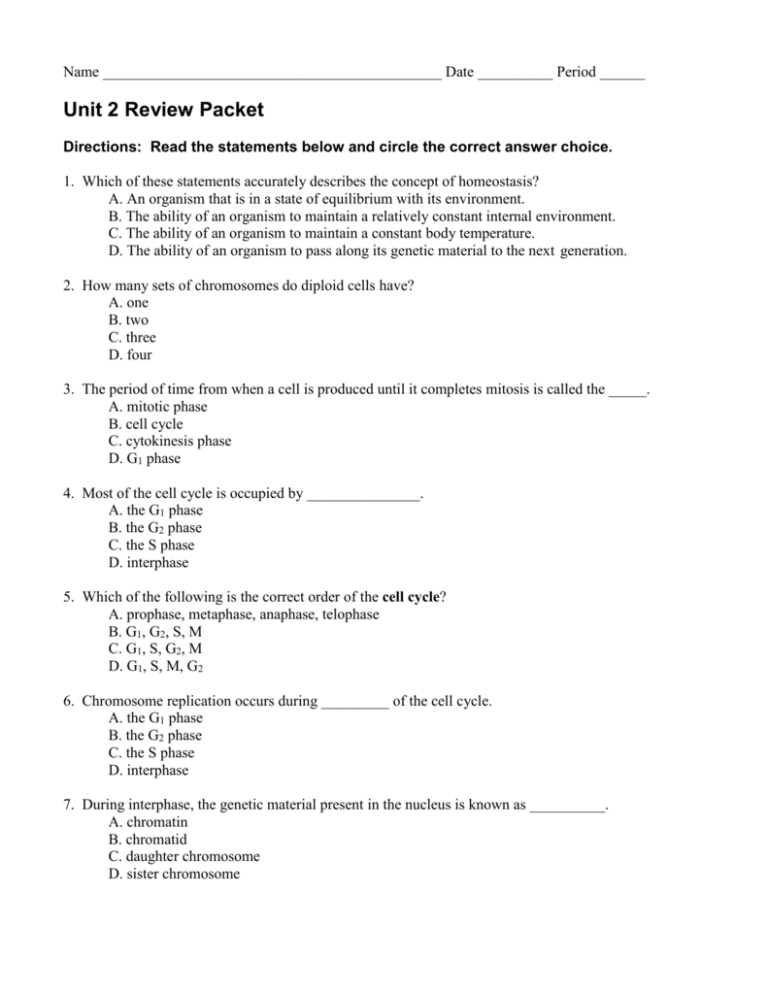
Name _____________________________________________ Date __________ Period ______ Unit 2 Review Packet Directions: Read the statements below and circle the correct answer choice. 1. Which of these statements accurately describes the concept of homeostasis? A. An organism that is in a state of equilibrium with its environment. B. The ability of an organism to maintain a relatively constant internal environment. C. The ability of an organism to maintain a constant body temperature. D. The ability of an organism to pass along its genetic material to the next generation. 2. How many sets of chromosomes do diploid cells have? A. one B. two C. three D. four 3. The period of time from when a cell is produced until it completes mitosis is called the _____. A. mitotic phase B. cell cycle C. cytokinesis phase D. G1 phase 4. Most of the cell cycle is occupied by _______________. A. the G1 phase B. the G2 phase C. the S phase D. interphase 5. Which of the following is the correct order of the cell cycle? A. prophase, metaphase, anaphase, telophase B. G1, G2, S, M C. G1, S, G2, M D. G1, S, M, G2 6. Chromosome replication occurs during _________ of the cell cycle. A. the G1 phase B. the G2 phase C. the S phase D. interphase 7. During interphase, the genetic material present in the nucleus is known as __________. A. chromatin B. chromatid C. daughter chromosome D. sister chromosome 8. A copy of a chromosome produced by replication is called a ______________. A. chromatin B. chromatid C. daughter chromosome D. sister chromosome 9. Which of the following is the correct order of the mitotic phase of the cell cycle? A. interphase, prophase, prometaphase, metaphase, anaphase, telophase B. interphase, prophase, prometapahse, metaphase, anaphase, telophase, cytokinesis C. prophase, prometaphase, metaphase, anaphase, telophase, cytokinesis, interphase D. prophase, prometaphase, metaphase, anaphase, telophase, cytokinesis 10. What structure is located on the centromere and attaches the chromatid to the spindle fibers? A. kinetochore B. centriole C. centrosome D. microtubule 11. During prophase, the spindle apparatus forms between the _____________ pairs. A. kinetochore B. centromere C. centrosome D. ribosome 12. During prophase, the sister chromatids are held together by the ______________. A. kinetochores B. centromeres C. centrosomes D. centrioles 13. Chromosomes, which are pairs of sister chromatids, become visible with the light microscope during _________. A. prophase B. metaphase C. anaphase D. telophase 14. In what phase of mitosis does the nuclear membrane disappear and the chromatid pairs attach to the spindle? A. prophase B. metaphase C. prometaphase D. telophase 15. The cytoplasm divides and two daughter cells are formed in which mitotic phase? A. cytokinesis B. metaphase C. anaphase D. telophase 16. Which of the statements about mitosis is false? A. Mitosis is division of the nucleus. B. Mitosis results in the production of two diploid cells. C. Mitosis results in the production of two haploid cells. D. Mitosis is necessary to produce new cells for growth and repair. 17. Where in an animal’s body does meiosis occur? A. in somatic cells B. in germ cells of the ovaries and testes C. in the zygote D. in cells that line the intestine 18. Which of the following statements about meiosis is true? A. Meiosis produces two daughter cells with a haploid number. B. Meiosis produces four daughter cells with a haploid number. C. Meiosis begins after the G1 phase of the cell cycle. D. Meiosis consists of one nuclear division. 19. During prophase I of meiosis, homologous chromosomes line up side-by-side in a process called _________________. A. genetic recombination B. meiosis II C. synapsis D. crossing over 20. Crossing over results in ___________. A. synapsis B. genetic cloning C. genetic recombination D. dyad formation 21. A unit of inheritance is __________. A. RNA B. an allele C. a trait D. a gene 22. The tetrads (homologous chromosome pairs) break apart during which phase of meiosis? A. prophase I B. anaphase I C. anaphase II D. telophase I 23. The period of time between telophase I and prophase II is called ____________. A. interkinesis B. G1 phase C. interphase II D. S phase 24. Which of the following statements is true about metaphase II? A. Sister chromatids split & move to opposite sides of the cell. B. Four cells are produced. C. Nuclear membrane and nucleolus break down. D. Chromatids line up at the mid-line of the cell. 25. Which of the following statements about prometaphase I is true? A. Sister chromatids split & move to opposite sides of the cell. B. Four cells are produced. C. Nuclear membrane and nucleolus break down. D. Chromatids line up at the mid-line of the cell. 26. Female gametes are _________. A. body cells B. only sperm cells C. only eggs cells D. both sperm and egg cells 27. Oogenesis gives rise to four ova. A. true B. false 28. Once the sperm cell fertilizes the egg cell, the resulting cell is known as a(n) ____________. A. ova B. blastula C. gastrula D. zygote 29. A hedgehog has 88 chromosomes in their body cells. How many chromosomes should be present in their gametes? A. 88 B. 176 C. 44 D. 22 30. The failure of chromosomes to segregate or separate in meiosis is known as __________. A. a translocation B. a substitution C. nondisjunction D. a deletion Be sure to study the mitosis and meiosis coloring pages and the cell cycle foldable. Use your Unit 2 test hints as a checklist for your studying.





